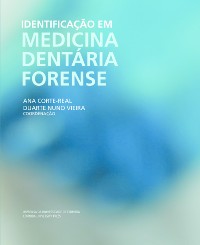Please use this identifier to cite or link to this item:
https://hdl.handle.net/10316.2/38400| DC Field | Value | Language |
|---|---|---|
| dc.contributor.author | Corte-Real, Ana | |
| dc.contributor.author | Oliveira, Carina | |
| dc.date.accessioned | 2016-01-18T17:16:44Z | |
| dc.date.accessioned | 2020-09-09T10:12:31Z | - |
| dc.date.available | 2016-01-18T17:16:44Z | |
| dc.date.available | 2020-09-09T10:12:31Z | - |
| dc.date.issued | 2015 | - |
| dc.identifier.isbn | 978-989-26-0083-3 | |
| dc.identifier.isbn | 978-989-26-0963-8 (PDF) | |
| dc.identifier.uri | https://hdl.handle.net/10316.2/38400 | - |
| dc.description.abstract | The scientific method used for identification is based on five assumptions: uniqueness, immutability, perpetuity, reproducibility and classification of a feature. This chapter highlights the characteristics of face analysis, teeth analysis and their interrelationships. Dentistry proved to be important in the context of forensic identification since: teeth are highly resistant to aggressive agents; the morphology of each tooth is distinctive; the radiographic registration of a medical record is routinely performed in the dental treatment in living individuals; the method of analysis is technically simple and inexpensive, and finally, the radiographic registration of the dental arches of cadavers can be contained in a database. In identification, the success rate through the dental structures presupposes the establishment of generic features such as gender, age and population affinity of the individual, supplemented with morphologic tests and genetic analysis that have high discrimination power. Documenting individualizing factors such as orofacial characteristics, teeth metric analysis, tooth morphology and occlusion, acquires a high expert value when applied to a comparative method with previous clinical records. Positive identification is assigned when a matching set of features allows you to establish without any discrepancy, the identity of the individual. One of the difficulties of dental identification is insufficient information of the anatomical findings in an epidemiological context, that is, the negligible distribution frequency of the different morphological characteristics by population affinity, that allows to assign a probability value of positive identification. Considering the above, the consistency of a result of identification by dental examination is in relation to the universe of suspects. | eng |
| dc.description.abstract | O método científico utilizado para identificação baseia-se em cinco pressupostos, designadamente, singularidade, imutabilidade, perenidade, reprodutibilidade e classificação de uma característica. Neste capítulo são destacadas as características de análise da face, dos dentes e respetivas interrelações. A Medicina Dentária revela-se importante no âmbito da identificação forense, na medida em que: os dentes são altamente resistentes a agentes agressivos; a morfologia de cada peça dentária é peculiar; o registo radiográfico de uma ficha clínica é executado por rotina no tratamento dentário em indivíduos vivos; a metodologia de análise é tecnicamente fácil e de baixo custo; e por último, o registo radiográfico das arcadas dentárias de cadáveres pode constar de uma base de dados. Na identificação, a taxa de sucesso através das estruturas dentárias pressupõe a determinação de características genéricas, tais como o género, a idade e a afinidade populacional do indivíduo, complementadas com os exames morfológicos e de análise genética que possuem elevado poder discriminatório. A documentação de fatores individualizantes, como por exemplo, características orofaciais, odontometrias, morfologia dentária e oclusão, adquire um elevado valor pericial quando aplicado um método comparativo com registos clínicos anteriores. A identificação positiva é atribuída quando um conjunto de características coincidentes permite estabelecer, sem qualquer discrepância, a identidade do indivíduo. Uma das dificuldades da identificação por análise dentária é a insuficiente informação dos achados anatómicos num contexto epidemiológico, ou seja, a exígua distribuição das frequências das distintas características morfológicas por afinidade populacional, que permita atribuir um valor de probabilidade de identificação positiva. Face ao exposto, a fiabilidade do resultado de uma identificação por análise dentária está em relação com o universo de suspeitos. | por |
| dc.language.iso | por | - |
| dc.publisher | Imprensa da Universidade de Coimbra | por |
| dc.relation.ispartof | http://hdl.handle.net/10316.2/36707 | por |
| dc.rights | open access | - |
| dc.subject | positive identification | eng |
| dc.subject | uniqueness | eng |
| dc.subject | immutability | eng |
| dc.subject | reproducibility | eng |
| dc.subject | classification | eng |
| dc.subject | perpetuity | eng |
| dc.subject | identificação positiva | por |
| dc.subject | unicidade | por |
| dc.subject | imutabilidade | por |
| dc.subject | perenidade | por |
| dc.subject | reprodutibilidade | por |
| dc.subject | classificação | por |
| dc.title | Fundamentos teóricos da Medicina Dentária para aplicação forense | por |
| dc.type | bookPart | por |
| uc.publication.firstPage | 15 | - |
| uc.publication.lastPage | 32 | - |
| uc.publication.location | Coimbra | por |
| dc.identifier.doi | 10.14195/978-989-26-0963-8_1 | - |
| uc.publication.digCollection | PB | por |
| uc.publication.orderno | 1 | - |
| uc.publication.area | Ciências da Saúde | por |
| uc.publication.bookTitle | Identificação em Medicina Dentária Forense | - |
| uc.publication.manifest | https://dl.uc.pt/json/iiif/10316.2/38400/208454/manifest?manifest=/json/iiif/10316.2/38400/208454/manifest | - |
| uc.publication.thumbnail | https://dl.uc.pt/retrieve/11138772 | - |
| uc.publication.parentItemId | 54520 | - |
| uc.itemId | 69724 | - |
| item.grantfulltext | open | - |
| item.fulltext | With Fulltext | - |
| Appears in Collections: | Identificação em Medicina Dentária Forense | |
Files in This Item:
| File | Description | Size | Format | |
|---|---|---|---|---|
| fundamentos_te_ricos_da_medicina_dent_ria_para_aplica__o_forense.pdf | 2.06 MB | Adobe PDF |  |
Items in DSpace are protected by copyright, with all rights reserved, unless otherwise indicated.
